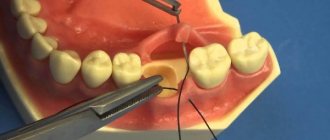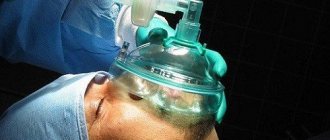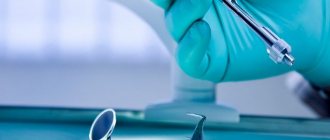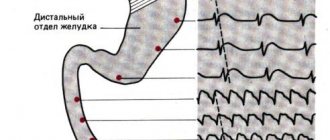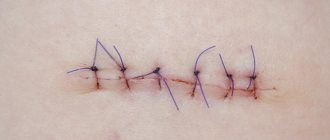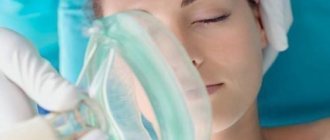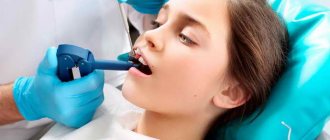How long does it take for threads to dissolve after surgery?
During surgery, absorbable sutures are increasingly used - so-called threads, which perform a fixing function: they hold damaged tissues and promote their healing. How long such threads take to dissolve depends on several factors - the place where they are applied, the individual characteristics of the body, but the main one is the material used to make the base of the threads.
Sutures after wisdom tooth removal: how long do threads take to dissolve?
Sutures are applied very often after the removal of a wisdom tooth, since this event is usually equated to an operation. Removing the eight can sometimes be very difficult. As a result, you have to cut the gum and sew it up after extracting the tooth.
The seams vary greatly in quality. They may resolve on their own or require specialist action in the future. In any case, after the operation it is necessary to check with the dental surgeon exactly what type of threads was used. But with the right approach, the specialist himself, without reminding the patient, will inform about the need for the next visit to remove the stitches.
Why are stitches needed?
Sutures are often used when removing a large dental problem such as a wisdom tooth. It is very difficult to rid the patient of this element without damaging the gums, so it is often necessary to additionally stitch the tissue.
Even with the most careful work of a dentist, it is difficult to get rid of a wisdom tooth without problems. It is located very deeply and is attached to the gum by two roots at once. To remove the outer teeth, the surgeon makes 1 or 2 incisions in the gum (see pictures below). After this, careful extraction is performed.
When wisdom teeth are removed, there is often a need for sutures. They can be applied even if there are signs of swelling on the gum. Tissue swelling is a completely natural process after trauma to the gums through incisions.
If the specialist applies the stitches correctly, the wounds should heal well. In this case, there should not be severe bleeding, since the first blood clot will not be displaced due to the sutures.
This procedure is also a preventive method, since the wound is closed and the risks of penetration of pathogenic microorganisms, of which there are quite a lot in the oral cavity, are minimized. That is, the smaller the wound, the less often it becomes infected and the faster it heals.
Regardless of what threads the dentist uses, suturing does not take much time. And yet, self-absorbing materials are more convenient, because in this case there will be no additional trauma to the body.
The quality of the scar and the wound healing time after wisdom tooth removal depend not only on how the suture is applied, but also on possible complications. Removing the last tooth is one of the most difficult dental operations, so additional complications are not excluded.
For difficult removal, sutures can be placed like this.
It is worth noting that when the removal of a wisdom tooth occurs without complications, and the doctor uses ordinary materials for suturing, the threads can be removed within a week. However, a specialist must first assess the condition of the oral cavity and exclude the development of pathology. Only after this will it become clear whether the stitches can be removed or whether they should be left in place for more complete healing of the wound.
How long does it take for threads to dissolve?
Special threads for suturing are very convenient, since when using them there is no need to further injure the surgical site. But not all patients know how long they need to wait for the process of thread resorption to complete.
As a rule, if high-quality suture material is used, not a trace will remain of it within 20–30 days after the operation.
It should be noted that the threads simply fall apart, and then the person unnoticed swallows them. There is no discomfort or danger if thread residues enter the stomach.
The advantage of using such material for suturing is that with them there is no need for an additional trip to the doctor. However, a week or two after surgery to remove a wisdom tooth, you should still visit the dentist to make sure that the surgical intervention did not lead to complications, for example, to an inflammatory process.
The exact time after which the seams will completely disappear is impossible to determine. But there are still approximate deadlines for each type of material.
In medical practice, 2 types of threads are widely used:
- The first type, namely classic catgut, has been used for decades.
This material has been used for more than a century, but recently it has begun to be replaced by new types of retainers. Classic threads can hold seams from 10 to 140 days. Over time, enzymes will begin to attack them, which will lead to their complete breakdown and elimination by the body. Nowadays, catgut is very often used when removing wisdom teeth. This operation is rarely done without stitches, but if you put them in, it’s very difficult to remove them. Absorbable sutures will be very useful. But it must be borne in mind that catgut cannot be used in situations where the risks of complications and inflammatory processes are very high. - More modern materials that are used today for suturing are synthetic threads such as Dexon and Vicryl. They are based on polyglycomic acid and polyclatin. It is convenient to create knots with such threads, which simplifies the surgeon’s work. Resorption of synthetic materials occurs through hydrolysis. It takes about a month for stitches of this type to completely disappear. Vicryl dissolves much faster than Dexon.
The advantage of synthetic thread is that it can be used to suture even in areas where the risk of complications is high. Vicryl and Dexon do not cause inflammation, so they can be used during any operations, even the most complex ones.
In any case, the patient must visit the doctor a week or two after the removal of the wisdom tooth. When using synthetic threads and the complete absence of complications, dentists try to get rid of stitches before they dissolve on their own.
What are absorbable sutures
This is the name given to retaining threads that lose their fixing properties within up to 4 months. In surgical practice, the following types of self-absorbing sutures are most often used:
- Catgut is an organic type of thread made from cow intestines. At the same time, it is the longest absorbable - catgut “lasts” up to 4 months;
- Lavsan is a synthetic thread created on the basis of polyesters. They are used when long-term fixation is not required, since the material quickly loses its holding power;
- Vicryl is another representative of synthetic sutures that are actively used in medicine, including cosmetics.
Besides those mentioned, there are many other types of materials used. Their choice depends on the type of intervention performed and the mobility of tissue in the area of the operation, so only a doctor can individually select threads that will not subsequently leave scars, but will resolve in a short time.
The main factors contributing to the independent destruction of such threads in human tissues are:
- Chemical reactions of the body based on the interaction of proteins;
- Chemical reactions of the material with water contained in the human body.
They provoke the dissolution of postoperative threads, which are used to tighten surgical tissue incisions for a short time.
Suture material in dentistry
Suture material (surgical thread)
indispensable for any surgical intervention. Its reliability, atraumaticity and biocompatibility with the tissues of the human body inevitably affect the outcome of the operation and the postoperative period without complications.
That is why there are many varieties of suture material, developed taking into account the characteristics of surgical operations and having certain advantages and unique qualities that meet the goals and objectives of each specific situation.
What type of suture material is there?
Suture material is made from different materials and, accordingly, differs in structure and biodestruction (resorption/non-resorption).
If we talk about structure, surgical threads are monofilament and multifilament.
Monofilament
, that is, a homogeneous surgical thread, has a smooth surface, the risk of injury during its use is significantly reduced. The advantage of such threads is also good elasticity, hydrophobicity, non-capillarity and non-wicking. The disadvantages include slipping, which means unreliability in the knot, which can be dealt with by tying several knots to strengthen the seam.
Another type of surgical threads are polyfilament
consisting of several fibers. This type of surgical threads is also durable, including due to special weaving, twisting or a complex manufacturing method. The obvious advantage of this type of suture material is its special impregnation and coating, which reduces the sawing effect of the thread, improves its sliding, and therefore its permeability through tissue, reducing the risk of thread breakage.
Another feature of the suture material
- its ability (or inability) to dissolve -
biodestruction
.
At the same time, not only natural threads, such as catgut, for example, can be absorbed, but also synthetic ones, among which the most popular is VICRIL.
- a synthetic suture material often used in dental surgical practice. Both surgical threads are reliable and comfortable to use, providing a favorable postoperative period without the need to remove sutures.
VICRIL suture material, even after two weeks after installation of the implants, remains more than 50% strong; then, after five weeks, VICRIL loses its strength and completely dissolves after three months, minimally damaging the tissue. You can buy VICRIL in Moscow at affordable prices, of the required length and thickness, with or without needles in our online store.
, conditionally absorbable surgical sutures are often used
, the line of which is headed by silk threads, nylon and polyurethane. This suture material is unusually flexible and obedient to any manipulation.
Non-absorbable surgical threads, such as lavsan, mersilene, prolene, etc., are not inferior to the previous type of suture material in manipulation properties, they are also atraumatic and durable, comfortable and, along with all the stated advantages, not expensive. The most popular non-absorbable suture material is PROLENE.
. PROLENE minimizes the inflammatory reaction and tissue trauma (with further encapsulation), does not grow together with surrounding tissues, making it easy to remove. Such properties allow the productive use of PROLENE in dental surgery, even taking into account the high risk of infection. You can also buy PROLENE in Moscow at competitive prices and in different configurations in our online store DentalMarket.online.
So, suture materials can be very different - organic, natural (silk, catgut, cellulose threads), inorganic, polymer, synthetic - but always of high quality. And even if you decide to use analogues of leading brands of suture materials, this condition is indisputable and absolute.
The best Russian import-substituting company for the production of suture materials is MZKRS.
MZKRS is the choice of professionals. High-quality suture materials are durable and resistant to infection, while being flexible, convenient for sterilization, reliable in knots, and hypoallergenic.
By choosing the best, you do the main thing - make the doctor’s work easier and speed up the patient’s recovery.
When to use absorbable sutures
This type of medical materials is used when suturing surgical wounds: such manipulations are carried out both on the surface of the skin, during cosmetic operations, and in deep layers of tissue, for example, during transplantation of internal organs.
The main function of such sutures is to maintain internal tissues in a stable condition until they grow together and begin to function without outside support.
It is advisable to use absorbable sutures in cases where the patient does not have the opportunity to return to the surgeon to remove the applied staples, clamps or sutures made of durable materials.
The most common use of absorbable sutures in gynecology is for suturing the perineum, tears in the vagina or cervix during natural childbirth. Studies have shown that during the postpartum period, the threads removed themselves within 2-4 months.
To understand how many days it takes for the threads to dissolve, you must first ask your surgeon what material was used for suturing. The doctor will not only clarify the information you are interested in, but will also advise how long it will take for the stitches to completely dissolve. Only a specialist can competently assess this process, taking into account the individual characteristics of the patient.
But in general, you need to know how long it takes for the threads to dissolve by looking at the type of threads used during the operation:
- Catgut begins to lose its fixing properties after a month, while the threads finally dissolve only at the end of the 4th month of wound healing;
- Lavsan is often used in cosmetology, since the material begins to deteriorate already on the 10-12th day, but this process can take up to 1.5 months;
- Vicryl has an average degree of resorption: the threads lose their strength after 2-3 months.
In this case, it is worth making allowances for proper care of the postoperative wound according to the scheme recommended by the supervising surgeon. If it is not handled correctly and the rules of personal hygiene are neglected, healing may be delayed and the process of suture resorption may worsen.
What happens to the wound after extraction?
Gum incision - cutting through soft tissue to provide access to problem areas.
This disrupts the integrity of blood vessels , nerves and muscles.
There is a bleeding hole near the incision itself.
The gum is sutured
The purpose of suturing is to minimize the distance between the edges of the socket and to close the cut gum.
Using suture material, how long does it last?
In free clinics, regular sutures are placed .
If healing proceeds without exacerbations, the patient is asked to come to the dentist after 7 days for examination and removal of sutures.
In modern dental clinics, absorbable suture material is used.
Two types of threads are used: vicryl and catgut. Their use does not cause inflammation of the gums and promotes rapid healing.
Catgut
A suture material that has the ability to dissolve in the tissues of living organisms. It is an elastic beige thread with a smooth surface . It is made from purified connective tissue from the intestines of cattle. Catgut sutures dissolve in the oral cavity 2 weeks after application to the wound.
Photo 1. The process of suturing the gums after extraction of a molar is shown to avoid infection.
Vicryl
Synthetic absorbable sterile suture material of purple color. It is made from a copolymer consisting of glycolide ( 90% ) and L-lactide ( 10% ). Vicryl causes a short-term inflammatory response in connective tissues.
Resorption of the threads occurs after 2 weeks . They will completely resolve in 50 - 85 days . Vicryl does not cause allergies, tightly holds the edges of the hole in the desired position and retains its properties for 3 months.
Reference. Vicryl is stronger than catgut.
If complications arise after suturing, you will need to visit the dentist again. If after tooth extraction the wound becomes infected or swelling, blueness and suppuration appear around the wound, you will have to remove the sutures and treat the wound with special solutions until the inflammation goes away. Once this happens, the doctor will re-suture the gum.
If the sutures are placed well, the gums heal quickly, bleeding does not occur and the first clot is well fixed. When the wound is closed, the risk of infection is reduced. Healing time depends on the size of the hole. If the doctor sees no medical contraindications, the sutures are removed.
When removed, how many days do the threads take to dissolve?
If the tooth extraction went without complications, and the doctor used regular suture material to sew up the gums, then the sutures are removed after 7 days.
The doctor evaluates the healing process, makes sure there is no inflammatory process, and only then sets a date for the procedure.
If you use absorbable threads, you will not need to remove sutures. The threads dissolve within 3 weeks. The advantage of absorbable sutures is that they do not injure the operated gum when they are removed, as is the case with conventional suture material.
How is the dressing done?
In most cases, this is an easy, quick and painless process. The timing of removal is determined by the attending physician; this usually occurs 7-8 days from the date of application. The procedure is carried out without the use of anesthesia and lasts no more than 1 minute .
If a wisdom tooth has been removed, an absorbable floss is used; there is no need to remove it. In the case of molar tooth extraction, a regular floss is sometimes used, which after the time prescribed by the doctor .
Thread removal process:
- The oral cavity is treated with an antiseptic to prevent infection.
- Cut the threads in half with a special tool.
- Remove the remaining threads with tweezers.
During removal, the patient may feel slight discomfort. This occurs as the suture is pulled to cut it and as the suture passes through healing tissue.
After removing the sutures, your mouth thoroughly
Important! Remember that regular suture material is a foreign body. If the threads are not removed, they will begin to rot , so you need to see a doctor on the appointed day!
What to do if the seams come apart?
If the suture breaks apart after tooth extraction, it means that the periosteum is inflamed (periostitis). The swollen gums and the pus formed in the hole push out the threads , this leads to the opening of the edges of the wound.
How to care for absorbable sutures
Having dealt with the question of how long it takes for the threads to dissolve, it is important to understand how to properly care for the suture after surgery so that healing proceeds safely, the threads are safely torn away, as quickly as possible, and there are no scars left at the site of the intervention.
Please pay attention to the following most important rules for caring for postoperative sutures:
- The most important point is the sterility of all manipulations performed. Before treating a wound, be sure to wash your hands and thoroughly disinfect all instruments.
- Depending on the nature of the sutured wound, it must be treated with an antiseptic - brilliant green, Fukortsin, potassium permanganate solution, hydrogen peroxide, medical alcohol. It is better to check with the supervising surgeon what exactly to use. You may have to combine medications and use them together with anti-inflammatory ointments.
- During water procedures, avoid friction; the wound can only be washed with warm water or a decoction of herbs.
- If we talk about postpartum sutures, then it is imperative to maintain intimate hygiene - this will prevent complications.
So, in order to find out how long it will take for the sutures to be successfully absorbed after surgery, you must first find out the material from which they are made. It is also worth taking into account the individual characteristics of the body: if you have a tendency to long-healing wounds, then be prepared for the fact that complete resorption of postoperative threads can take up to six months, especially if organic materials were used during suturing of the wound.
Why did you need stitches after wisdom tooth removal?
If the operation turned out to be difficult and the soft gum tissues were damaged , sutures are placed on them.
In particularly difficult situations , such as the removal of wisdom teeth, the doctor has to resort to stitches on the operated area.
Since the wisdom tooth grows deeply and has several roots, the dentist is forced to make incisions on the gums to properly extract the roots.
Sutures are placed on the gums for the purpose of:
- preventing bleeding from the wound;
- maintaining a blood clot in the socket;
- preventing food from getting into the wound;
- reducing the risk of socket injury;
- When a suture is applied, the wound heals faster.
Removal of a molar tooth is not always accompanied by surgical intervention; in these cases, need to suture the wound.
Stitches after circumcision
The seams came apart after circumcision of the foreskin - what to do?
It often happens that the seams come apart after circumcision. This occurs if the patient had an erection earlier than intimacy allowed after surgery. At this point, the young scar tissue has not yet formed enough. The second reason is an awkward sudden movement during sexual intercourse. Therefore, abstinence from sex is mandatory.
In order to reduce erectile function, medications that reduce activity are prescribed. It is necessary to consult a doctor as soon as possible, who will advise further actions. To avoid rough and unaesthetic scarring, in most cases there is a need for repeated surgical manipulation and suturing after circumcision.
Infection often occurs through an open wound. The site of damage may become covered with crust or plaque, and in severe cases, suppuration is observed. It is important to take adequate measures in time to prevent the development of pathology. First, multiple rinses are performed. When the inflammation subsides, a second operation is performed.
When stitching, a special catgut thread is often used. Sometimes it happens that self-absorbing sutures partially remain after circumcision. Residual fragments cause some discomfort, so you should remove them yourself or seek medical help. The use of catgut is not insurance against discrepancy.
Consultation with a urologist on the issue: “Sutures after circumcision”
To successfully complete post-operative recovery, you need to follow simple rules:
- The first 2-3 dressings are best done by a doctor;
- it is necessary to change bandages daily, pre-soaking them in hydrogen peroxide;
- for the first ten days, the surgical site should be treated with antiseptic ointment, followed by application of a sterile bandage;
- in the second week, the wounds should be opened for natural drying;
- It is recommended to abstain from intimacy for 2–3 weeks.
If you experience pain, abnormal continuous discharge, or pathological changes in the surface of the penis, you should immediately seek medical help.
Why are stitches needed?
Sutures are often used when removing a large dental problem such as a wisdom tooth. It is very difficult to rid the patient of this element without damaging the gums, so it is often necessary to additionally stitch the tissue.
Even with the most careful work of a dentist, it is difficult to get rid of a wisdom tooth without problems. It is located very deeply and is attached to the gum by two roots at once. To remove the outer teeth, the surgeon makes 1 or 2 incisions in the gum (see pictures below). After this, careful extraction is performed.
When wisdom teeth are removed, there is often a need for sutures. They can be applied even if there are signs of swelling on the gum. Tissue swelling is a completely natural process after trauma to the gums through incisions.
If the specialist applies the stitches correctly, the wounds should heal well. In this case, there should not be severe bleeding, since the first blood clot will not be displaced due to the sutures.
This procedure is also a preventive method, since the wound is closed and the risks of penetration of pathogenic microorganisms, of which there are quite a lot in the oral cavity, are minimized. That is, the smaller the wound, the less often it becomes infected and the faster it heals.
Regardless of what threads the dentist uses, suturing does not take much time. And yet, self-absorbing materials are more convenient, because in this case there will be no additional trauma to the body.
The quality of the scar and the wound healing time after wisdom tooth removal depend not only on how the suture is applied, but also on possible complications. Removing the last tooth is one of the most difficult dental operations, so additional complications are not excluded.
For difficult removal, sutures can be placed like this.
It is worth noting that when the removal of a wisdom tooth occurs without complications, and the doctor uses ordinary materials for suturing, the threads can be removed within a week. However, a specialist must first assess the condition of the oral cavity and exclude the development of pathology. Only after this will it become clear whether the stitches can be removed or whether they should be left in place for more complete healing of the wound.
How to treat sutures and wounds after a mastectomy at home
To treat sutures and wounds after mastectomy surgery at home, use antiseptics (solution of iodine, brilliant green, potassium permanganate, Chlorhexidine, Miramistin, Dioxidin), ointments (Kontraktubeks, Eplan, Levomekol).
After removal of the mammary gland, you must follow the general rules of care:
- inspect the postoperative suture daily, and if any discharge, swelling or redness of the skin appears, see a doctor;
- treat the wound site 2-3 times a day with an antiseptic liquid, it can be alcohol, Chlorhexidine, iodine, brilliant green, pink solution of potassium permanganate, Furacilin, Dioxidin, Miramistin as prescribed by the surgeon;
- apply a sterile bandage.
From the time the dry crusts come off, you need to lubricate the scar with creams, gels and ointments. This helps speed up healing and prevent the formation of too dense tissue. The surgeon may recommend: Actovegin, Solcoseryl, Vulnuzan, Levomekol, Contractubex, Stellanin. The choice of specific drugs remains with the specialist, since upon discharge he determines the stage of healing and the risks of complications.
The natural desire after surgery is to look as if the breasts have always been like this without intervention. This will become possible only after at least 2 months. But even then the scar will change, becoming more and more smoothed out and invisible. The whole process can last a year. It also depends on what material was used during the operation:
- If self-absorbable threads were used to fasten the edges of the wounds (which happens with light intervention), they will disappear after 2 - 3 months. There is no need to remove them from the body, but caring for the sutures is still necessary.
- The use of synthetic threads requires their subsequent removal. Of course, the patient is eager to know in advance when the sutures are removed after mammoplasty. This will happen after 7 - 10 days. The doctor will evaluate the condition of the tissue dissection sites, the degree and quality of their healing.
- Haste can lead to the formation of rough, prominent scars, which will then have to be treated. And in the worst case, they may separate, or inflammation may occur in this area.
Removal of stitches after laser breast augmentation
Removing stitches can be a little painful. To a greater extent, it depends on the mood of the patient herself. If she is afraid in advance, she involuntarily tenses, which intensifies the negative sensations. But the manipulation itself to remove the suture material is quite fast.
Another sign that causes concern and suspicion that not everything is going as it should is pain at rest and during movement. This feeling is natural, because living tissues and blood vessels were damaged during the operation. It lasts about 7 days. Very susceptible women complain that their stitches hurt after mammoplasty for up to 2 - 3 weeks. If all this time the feeling is decreasing, there are no other alarming signs, it does not indicate anything dangerous.
The pain in the area of the sutures may be stronger due to excessive physical activity of the woman, especially when the upper half of the body is involved (raises the arms, moves the shoulders). Incorrectly selected compression garments can provoke the sensation. In this case, it will need to be changed to a more suitable size.
This is the name given to retaining threads that lose their fixing properties within up to 4 months. In surgical practice, the following types of self-absorbing sutures are most often used:
- Catgut is an organic type of thread made from cow intestines. At the same time, it is the longest absorbable - catgut “lasts” up to 4 months;
- Lavsan is a synthetic thread created on the basis of polyesters. They are used when long-term fixation is not required, since the material quickly loses its holding power;
- Vicryl is another representative of synthetic sutures that are actively used in medicine, including cosmetics.
Besides those mentioned, there are many other types of materials used. Their choice depends on the type of intervention performed and the mobility of tissue in the area of the operation, so only a doctor can individually select threads that will not subsequently leave scars, but will resolve in a short time.
The main factors contributing to the independent destruction of such threads in human tissues are:
- Chemical reactions of the body based on the interaction of proteins;
- Chemical reactions of the material with water contained in the human body.
They provoke the dissolution of postoperative threads, which are used to tighten surgical tissue incisions for a short time.
This type of medical materials is used when suturing surgical wounds: such manipulations are carried out both on the surface of the skin, during cosmetic operations, and in deep layers of tissue, for example, during transplantation of internal organs.
The main function of such sutures is to maintain internal tissues in a stable condition until they grow together and begin to function without outside support.
It is advisable to use absorbable sutures in cases where the patient does not have the opportunity to return to the surgeon to remove the applied staples, clamps or sutures made of durable materials.
The most common use of absorbable sutures in gynecology is for suturing the perineum, tears in the vagina or cervix during natural childbirth. Studies have shown that during the postpartum period, the threads removed themselves within 2-4 months.
To understand how many days it takes for the threads to dissolve, you must first ask your surgeon what material was used for suturing. The doctor will not only clarify the information you are interested in, but will also advise how long it will take for the stitches to completely dissolve. Only a specialist can competently assess this process, taking into account the individual characteristics of the patient.
But in general, you need to know how long it takes for the threads to dissolve by looking at the type of threads used during the operation:
- Catgut begins to lose its fixing properties after a month, while the threads finally dissolve only at the end of the 4th month of wound healing;
- Lavsan is often used in cosmetology, since the material begins to deteriorate already on the 10-12th day, but this process can take up to 1.5 months;
- Vicryl has an average degree of resorption: the threads lose their strength after 2-3 months.
In this case, it is worth making allowances for proper care of the postoperative wound according to the scheme recommended by the supervising surgeon. If it is not handled correctly and the rules of personal hygiene are neglected, healing may be delayed and the process of suture resorption may worsen.
Having dealt with the question of how long it takes for the threads to dissolve, it is important to understand how to properly care for the suture after surgery so that healing proceeds safely, the threads are safely torn away, as quickly as possible, and there are no scars left at the site of the intervention.
Please pay attention to the following most important rules for caring for postoperative sutures:
- The most important point is the sterility of all manipulations performed. Before treating a wound, be sure to wash your hands and thoroughly disinfect all instruments.
- Depending on the nature of the sutured wound, it must be treated with an antiseptic - brilliant green, Fukortsin, potassium permanganate solution, hydrogen peroxide, medical alcohol. It is better to check with the supervising surgeon what exactly to use. You may have to combine medications and use them together with anti-inflammatory ointments.
- During water procedures, avoid friction; the wound can only be washed with warm water or a decoction of herbs.
- If we talk about postpartum sutures, then it is imperative to maintain intimate hygiene - this will prevent complications.
So, in order to find out how long it will take for the sutures to be successfully absorbed after surgery, you must first find out the material from which they are made. It is also worth taking into account the individual characteristics of the body: if you have a tendency to long-healing wounds, then be prepared for the fact that complete resorption of postoperative threads can take up to six months, especially if organic materials were used during suturing of the wound.
How long does it take for threads to dissolve?
Special threads for suturing are very convenient, since when using them there is no need to further injure the surgical site. But not all patients know how long they need to wait for the process of thread resorption to complete.
As a rule, if high-quality suture material is used, not a trace will remain of it within 20–30 days after the operation.
It should be noted that the threads simply fall apart, and then the person unnoticed swallows them. There is no discomfort or danger if thread residues enter the stomach.
The advantage of using such material for suturing is that with them there is no need for an additional trip to the doctor. However, a week or two after surgery to remove a wisdom tooth, you should still visit the dentist to make sure that the surgical intervention did not lead to complications, for example, to an inflammatory process.
The exact time after which the seams will completely disappear is impossible to determine. But there are still approximate deadlines for each type of material.
In medical practice, 2 types of threads are widely used:
- The first type, namely classic catgut, has been used for decades. This material has been used for more than a century, but recently it has begun to be replaced by new types of retainers. Classic threads can hold seams from 10 to 140 days. Over time, enzymes will begin to attack them, which will lead to their complete breakdown and elimination by the body. Nowadays, catgut is very often used when removing wisdom teeth. This operation is rarely done without stitches, but if you put them in, it’s very difficult to remove them. Absorbable sutures will be very useful.
But it must be borne in mind that catgut cannot be used in situations where the risks of complications and inflammatory processes are very high.
- More modern materials that are used today for suturing are synthetic threads such as Dexon and Vicryl. They are based on polyglycomic acid and polyclatin. It is convenient to create knots with such threads, which simplifies the surgeon’s work. Resorption of synthetic materials occurs through hydrolysis. It takes about a month for stitches of this type to completely disappear. Vicryl dissolves much faster than Dexon.
The advantage of synthetic thread is that it can be used to suture even in areas where the risk of complications is high. Vicryl and Dexon do not cause inflammation, so they can be used during any operations, even the most complex ones.
In any case, the patient must visit the doctor a week or two after the removal of the wisdom tooth. When using synthetic threads and the complete absence of complications, dentists try to get rid of stitches before they dissolve on their own.
Care after mammoplasty
The success of the operation depends on care after mammoplasty: treating the suture with alcohol, Miramistin, other antiseptics, applying healing and absorbable ointments.
It is recommended to treat scars on the nipple areola after mammoplasty surgery with alcohol until the crusts covering the wound fall off on their own. Use either alcohol or solutions of iodine, brilliant green at the discretion of the doctor. At the next stage of treatment, absorbable ointments are used.
Your doctor may recommend a cream after breast reconstruction to help the wound heal faster:
- Contractubex – has a softening, anti-inflammatory effect, contains heparin, onion extract and allantoin;
- Dermatix is a silicone gel that smooths out protruding scars and lightens them;
- Imoferase – based on the enzyme hyaluronidase, reduces redness, pigmentation, itching, dryness, moisturizes;
- Vulnuzan – contains salts from Lake Pomorie, has a strong anti-inflammatory and cleansing effect, is used for long-term non-healing wounds;
- Eplan is the active ingredient glycolan, it inhibits the growth of bacteria, relieves pain, stimulates tissue restoration, and relieves swelling;
- Stellanin - exhibits both antimicrobial and wound-healing effects, accelerates the fusion of suture edges during inflammation;
- Mederma - softens scar tissue, prevents keloid formation. A similar result is provided by: Kelocode, Dermofibraze, Dermatix, Contrarubet, Zeraderm.
After mammoplasty surgery, creams, gels and ointments are recommended for healing scars on the nipples; the most effective ones include: Dermatix, Mederma, Kelofibrase, Contractubex, Imoferase. They are applied after drying and rejection of dense crusts.
To treat a seam at home, Miramistin is applied to the surface of the skin. It is most convenient to use a spray bottle. First you need to remove the remnants of the bandage covering the wound. If it is difficult to remove, you can moisten it with hydrogen peroxide. Then Miramistin solution is sprayed and left until dry. This drug has a wide spectrum of antimicrobial action and is indicated for the treatment of purulent and uncomplicated postoperative wounds.
What foods should you eat to help your stitches heal faster after breast surgery?
To speed up the healing of sutures after breast surgery, you need to eat foods containing:
- protein – cottage cheese, fish, chicken, turkey;
- collagen – berry, fruit jelly, jellied meat;
- vitamin C – sea buckthorn berries, black currants, bell peppers, kiwi;
- vitamin A and provitamin carotene – carrots, liver, parsley, tuna, yolk;
- zinc – pine nuts, peanuts, beans, oatmeal.
To make the stitches on your chest heal faster, you need to:
- do not load the shoulder girdle - avoid lifting heavy objects, active movements of the limbs until scar tissue forms (from 15 to 20 days);
- monitor the condition of the wound, treat it with antiseptics, lubricate it with cream as prescribed by the surgeon;
- take a shower in the first month, covering the seam with a bandage;
- be sure to wear underwear with a slimming effect, and you should have at least 2 sets to change to clean ones every day;
- prevent pressure on the seam, do not sleep on your side.
It is possible to wet the suture after breast surgery only after a while - usually on the 2-3rd day, since the drainage must be removed. The doctor may then allow the patient to take a warm shower, but the wound must be covered with a bandage. The water temperature should be moderately warm; it is better to use regular baby soap or gel with a neutral pH.
It is important to consider that if there are signs of inflammation, surgeons prohibit water procedures; then you should wipe the body with wet wipes in the area of the mammary glands. Bathing is not recommended for at least 1 month.
How to care for seams: brief instructions
For a speedy recovery, it is important that postoperative sutures scar normally. Even if the material was self-absorbable, they need care, because the tissues injured during the intervention will not heal instantly. This will take time, during which you need to ensure that no infection gets into the wounds and that the edges remain securely fastened.
Proper care will ensure not only a quick recovery, but also the absence of obvious signs that the woman had plastic surgery. What does it consist of:
- On the first postoperative day you need to rest in a semi-sitting position. This will help to avoid heavy load on the seams, hence their possible divergence.
- It is necessary to control the appearance of scars. At first they are red, but as they heal they turn pale and shrink in size.
Change in color of scars after mammoplasty within a year
- Sometimes the attending physician recommends treating the seams after mammoplasty with antibiotic ointments, in other cases they insist on simply wiping them with sterile wet wipes. Experts prescribe using brilliant green and other solutions to prevent infection.
- In each case, you need to follow the recommendations, since the material used for suturing varies, as do the individual characteristics of tissue healing. Therefore, you should not be arbitrary in choosing care products, ignoring the doctor’s opinion.
- After removing the sutures, you can apply absorbable creams and ointments to them, after consulting with your surgeon. Contractubex will help improve the appearance of scars by applying a silicone strip to the incision site overnight.
- It is mandatory to wear compression garments for 30 days. It will help to avoid excessive tension of the skin in the area of the seam, that is, it will not allow it to hurt longer than expected and, moreover, will not allow it to separate. And to prevent infection, you should change your underwear daily.
Compression garments are put on the patient immediately after surgery.
- You can wash only 3 - 4 days after the operation, avoiding getting water and shower gel on the suture areas. It is best to do this with a bandage, removing it after the procedure. You cannot rub the body in the area of the mammary glands with a washcloth for 3-4 weeks.
- You need to avoid physical activity for at least 2 to 3 weeks. Rest helps damaged tissues heal faster and relieve pain in the suture area. This is also important for their correct formation without hypertrophy.
- You will have to sleep on your back, without turning on your side or stomach, for at least 2 - 3 weeks. This way, it will be possible to relieve the skin of excessive tension, therefore, avoiding increased blood supply in the area of the sutures, the risk of their damage and hypertrophic development.
Consequences of intervention
Healing of the sutures occurs with the formation of fibroblasts, which eliminate the tissue defect resulting from the incision. An epithelial coating then forms in the wound, preventing bacteria from entering.
Gradually, the edges of the wound are attracted to each other. Thin seams are formed, which, with favorable developments, are hardly noticeable, but are still visible. Carrying out mammoplasty involves their location in such places that prying eyes will be unable to detect its traces.
What is important for good seam aesthetics besides maintenance:
- Age. In young people, healing proceeds faster due to a high ability to regenerate and a more active immune system.
- Normal weight. With its excess or deficiency, recovery occurs more slowly.
- Nutrition. It must be complete to ensure the supply of “building material” for newly formed tissues. Sufficient intake of fluid into the body is also important.
- No bad habits. Alcohol and smoking interfere with the production of new cells.
Result of mammoplasty
Other complications
With a high-quality operation and good care after it, negative consequences in the suture area are rarely detected. But each organism is unique, in addition, anesthesia and the intervention itself provoke some suppression of the immune system. Therefore, complications cannot be 100% excluded:
- Inflammation. It can occur due to bacteria entering the wound, as well as from the body’s rejection of implants. If the seam is red, swollen and the area around it hurts, this is an alarming sign. Most likely, you will need treatment with antibiotics, possibly dissection, washing the wound and re-fixing the edges of the injured tissue.
- Sometimes you have to remove the implants, undergo treatment and perform the operation again. If after 2 weeks swelling in the suture area persists or reappears, the temperature rises, pain occurs in the problem area and head, the incision oozes purulent fluid and blood, you should definitely consult a doctor.
- Formation of a hypertrophic or keloid scar. Complications can develop due to insufficient care. But sometimes the culprit is a feature of the body that was not previously detected because the woman had not previously undergone surgery at all. Thin, almost imperceptible stripes remain after the intervention for everyone. But hypertrophy must be treated, sometimes surgically.
- Seroma. It can occur not only in the immediate vicinity of the implant, but also in the suture area. Then serous fluid is released from it. If you don't take action, it's not far from here to inflammation.
- Seam divergence. This problem is also not difficult to notice yourself. If the suture breaks after mammoplasty, you need to see a doctor as soon as possible. Until his help arrives, the area of tissue damage should be treated with an antiseptic (iodine or brilliant green).
If the suture pulls or tingles, or there is pain, this means that the healing process is taking place. These symptoms are not cause for concern if:
- localized only in the wound area;
- gradual subsidence of pain;
- reducing swelling;
- absence of fever, headache, chills, twitching pain;
- availability in the first weeks.
Moderate pain occurs for at least 2 months, but in some women it is felt in the first six months after surgery.
